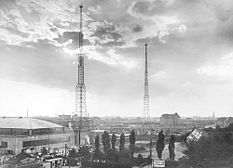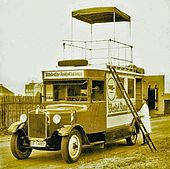Mitteldeutsche Rundfunk AG
The Central German Broadcasting AG (Mirag) was a broadcasting company and one of the oldest radio stations in Germany .
history
MIRAG was founded on January 22nd, 1924 in Leipzig . Its full name was Mitteldeutsche Rundfunk AG - Society for Wireless Entertainment and Teaching Leipzig . The share capital was 80,000 gold marks . The main shareholder was Edgar Herfurth & Co. KG, a newspaper company.
Broadcasting began on March 2, 1924. That was one day before the start of the spring fair this year in Leipzig, where the young radio industry wanted to demonstrate its capabilities. At the beginning of its operation, the transmitter used rooms in the Alte Waage am Markt in Leipzig, where the Leipzig Exhibition Office was based. Therefore the first announcement of the station was "Hello, hello - this is Leipzig, this is the Leipzig Messamtssender of the Reichs-Telegraphen-Verwaltung for Central Germany, we are broadcasting on wave 450". The transmitter identification and the pause sign was an alarm clock ticking 240 times a minute.
In addition to the administration and recording rooms, the technical facilities were also housed in the Alte Waage. The transmitting antennas were initially located in the New Johannis Hospital , 1.7 kilometers away . With this facility, the transmitter could be received well up to a distance of 150 kilometers. This served the Oberpostdirektionsbezirke (OPD) Leipzig, Dresden , Chemnitz , Erfurt , Halle , 1/2 Magdeburg and 1/3 Braunschweig , ie completely or partially the states of Saxony , Thuringia , Anhalt , Braunschweig and Prussia . MIRAG received part of the reception fees of two marks a month (from April 1924) collected by the post office for programming. The number of participants increased from 48,331 at the end of 1924 to 349,283 in 1929 to 638,000 at the end of 1929 with over nine million inhabitants in the transmission area.
In 1926, a new transmission antenna system with two 105 meter high steel lattice towers was built on the grounds of the Technical Fair . From 1932, broadcasting operations were taken over by the newly built radio station Wiederau 18 kilometers south of Leipzig, initially with 125 meter high wooden lattice antenna masts. (Access to further pictures below under web links )
On August 16, 1928, MIRAG moved into two floors in Barthels Hof on the northwest corner of the market for its expanded broadcasting operations . On February 28, 1933, the broadcasting corporation was converted into a GmbH . From April 1, 1934, MIRAG was subordinate to the Reichs-Rundfunk-Gesellschaft (RRG) and was given the name Reichssender Leipzig . From 1941 onwards, due to the war, hardly any individual contributions were produced and the central "Reichsprogramm" was adopted instead. In March 1945 broadcasting was stopped. After the Second World War, the Mitteldeutsche Rundfunk began operating on June 4, 1946 in the former insurance building on Springerstrasse in Gohlis , which had been converted into a broadcasting house , as Barthels Hof had been bombed. From 1952, however, the Mitteldeutsche Rundfunk fell victim to the centralization of radio operations in the GDR, with the Funkhaus Leipzig functioning as the regional feeder for Radio GDR I and II . In 1990, the Central German Broadcasting Corporation (MDR) was founded as a three-country broadcaster within the ARD , which began broadcasting on January 1, 1992 with three regional programs and three transnational programs.
organization
MIRAG was headed from the start by Erwin Jaeger, who was a physician by nature, but was one of the founding circle of Leipziger Rundfunk. He was replaced by Fritz Kohl in 1928, but remained an employee of MIRAG. In 1929 the board of directors was divided into “commercial and technical management” (director Kohl) and “artistic management” (general manager). Ludwig Neubeck took over the latter function . The board of directors was controlled by a multi- member supervisory board to which, notably, the main shareholder Herfurth was not a member because of the required non-partisan broadcasting.
The two main components of the program, word and music, also corresponded to the two departments of the station, the “literary department” and the “musical department”. The former was headed by Julius Witte until 1928 and Eugen Kurt Fischer from 1930 . Georg Witkowski and later Arno Schirokauer acted as literary advisors . Alfred Szendrei headed the musical department. He was also the conductor of the MIRAG orchestra, which had existed since 1925, with a strength of between 20 and 30 musicians (“house band”). The Leipzig Symphony Orchestra , whose conductor was Szendrei and who tied it to the radio, as well as the Leipzig Oratorio Association and others also played a part in the program. On October 1, 1931, the two orchestras merged, so that, taking into account its roots, the oldest radio orchestra still in existence in Germany was created. The oratorio association later became the radio choir . On October 31, 1931, Szendrei was fired. Erich Liebermann-Roßwiese took over the newly created concert department .
Since February 1925, MIRAG has owned the secondary transmitter Dresden . Its director was Eugen Emil Horath, the literary direction was in the hands of Kurt Arnold Findeisen , who took over the MIRAG school radio in 1931. In addition, MIRAG had other small branches, so-called meeting points , in Weimar , Chemnitz, Gera , Jena , Erfurt , Sondershausen and Eisenach .
Programming
The program duration was initially four hours per day and reached more than 14 hours in the early 1930s. All contributions were broadcast live .
Initially, the verbal contributions were mostly lectures of around 30 minutes. The range of topics ranged from radio-technical questions about music, theater, literature, history, philosophy, psychology and pedagogy to geography, economics and law as well as agriculture, with entire series of topics being designed. The news was mostly newspaper reports that Edgar Herfurth's “Leipziger Neuesten Nachrichten” delivered free of charge. As early as the summer of 1924 there was a regional sports radio and from October religious morning devotions on Sundays, but these were not organized by the churches. The radio play soon gained special significance as a new art form in the new medium of broadcasting . Julius Witte did pioneering work here.
Words and music were roughly the same in the program. There was a one and a half hour afternoon concert every day and an evening concert, mostly with the house band. Public concerts with the Leipzig Symphony Orchestra were also broadcast. The Bunte Abend - a mixture of entertaining music and recitations - had its premiere as early as May 1924 .
On May 3, 1930, the MIRAG school radio began operating.
literature
- Horst Riedel: Stadtlexikon Leipzig from A to Z. PRO LEIPZIG, Leipzig 2005, ISBN 3-936508-03-8 , pp. 514 and 40
- Joachim-Felix Leonhard (Ed.): Program history of radio in the Weimar Republic , Volume 1, Deutscher Taschenbuchverlag 1997, ISBN 978-3423047029 ( excerpt as pdf )
- Hansdieter Hoyer: The diamond pattern has remained - living in the old radio house Springerstraße , In: Leipziger Blätter Heft 57, Passage Verlag Leipzig 2010, p. 53
Web links
- German Broadcasting Archive History of MIRAG (PDF; 196 kB)
- The Mitteldeutsche Rundfunk AG "Mirag". Retrieved March 18, 2017 .
Links to pictures of the Leipzig City History Museum:
- Recording room in the Alte Waage
- Fitting of the first transmitter in the Alte Waage
- Antenna masts on the Johannishospital
- Antenna masts on the grounds of the technical fair
- 125 m towers in Wiederau
Individual evidence
- ↑ Mirag was the sixth of the first nine broadcasting stock corporations founded in the German Reich, but was the second to go on air as Reichsrundfunk with an official program regulated by the Reich Ministry of Post. See Horst O. Halefeldt: 2. Broadcasting companies and broadcasting regulations , In: Joachim-Felix Leonhard (Hrsg.): Programmgeschichte des Hörfunks in der Weimarer Republik , Volume 1, Deutscher Taschenbuchverlag 1997, ISBN 978-3423047029 , p. 30 ( excerpt as pdf , here page 14 ( Memento of the original from November 4, 2011 in the Internet Archive ) Info: The archive link has been inserted automatically and has not yet been checked. Please check the original and archive link according to the instructions and then remove this note. )
- ↑ At the beginning there is the "Mirag". Retrieved March 18, 2017 .






